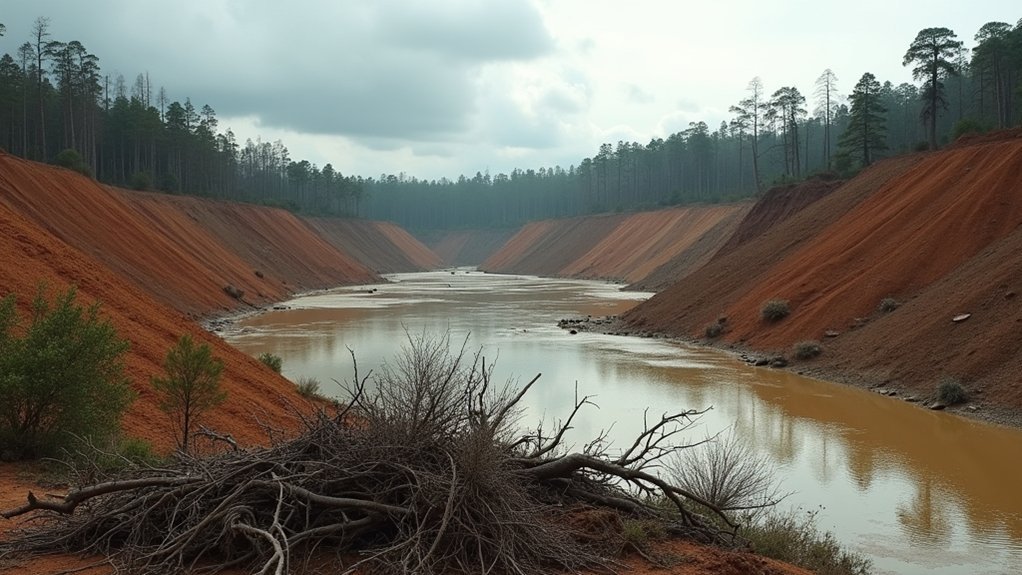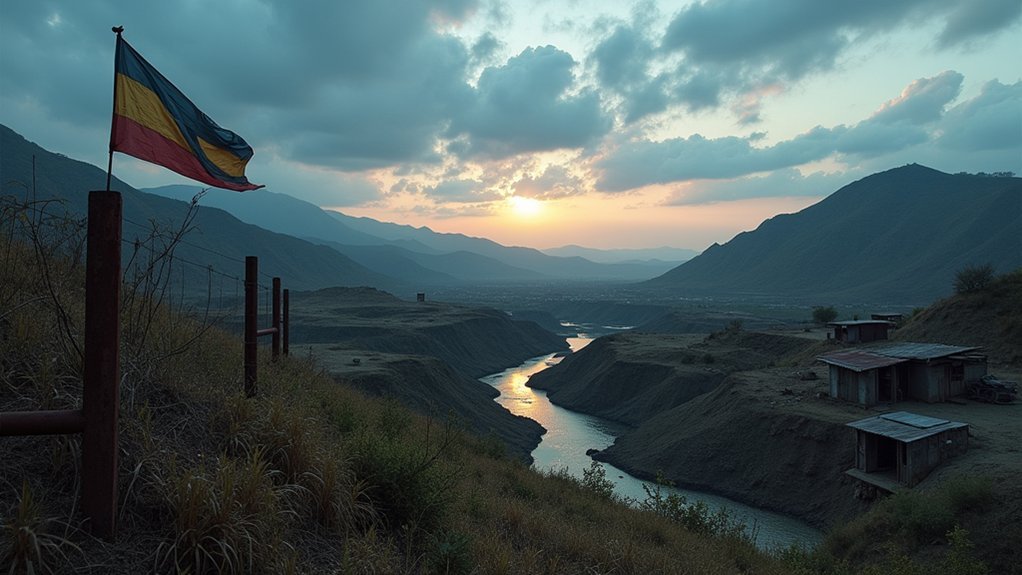Artisanal mining’s hidden costs devastate communities through severe environmental destruction and mercury contamination that poisons ecosystems with 1,400 tons annually. You’ll find over 600,000 exploited children working dangerous conditions while women face violence and wage discrimination. Local miners earn pennies as profits flow to middlemen, creating cycles of poverty and inequality. Communities lose ancestral lands, agricultural livelihoods collapse, and social structures crumble. These devastating impacts reveal the true price behind every extracted ounce.
Environmental Degradation and Ecosystem Destruction

While artisanal mining provides livelihoods for millions worldwide, it’s wreaking havoc on the environment in ways that extend far beyond the extraction sites themselves.
You’re looking at severe environmental degradation where unregulated practices strip away fertile topsoil and contaminate surrounding areas. Mercury emissions alone reach 1,400 tons annually from gold extraction, poisoning local ecosystems and creating serious health risks for nearby communities.
The ecosystem destruction doesn’t stop there.
You’ll find widespread deforestation as miners clear vegetation, leading to significant biodiversity loss and habitat destruction. Soil erosion follows, sending sediment into waterways and disrupting aquatic life.
This contamination affects entire water systems, while the loss of vegetation accelerates further environmental damage, creating a destructive cycle that impacts wildlife and communities for generations.
Mercury Contamination and Public Health Risks
Although environmental damage from artisanal mining is devastating, the mercury contamination creates an even more insidious threat that’s poisoning entire communities.
You’re witnessing the world’s largest source of man-made mercury pollution, with artisanal mining releasing 1,000 tonnes annually into soil, water, and air.
This exposure creates severe public health risks you can’t ignore. Mining communities face brain damage, developmental delays, and respiratory diseases affecting miners and nearby populations alike.
Women and children bear the heaviest burden, experiencing long-term health issues from contaminated resources.
Without protective measures in informal operations, you’re seeing widespread health crises emerge.
The environmental impacts extend beyond mining sites, contaminating food chains and creating chronic illnesses that devastate entire regions for generations.
Exploitation of Women and Children in Mining Communities

Beyond the environmental and health devastation, artisanal mining creates a breeding ground for human exploitation that targets society’s most vulnerable members.
Artisanal mining systematically exploits women and children, creating cycles of abuse that trap society’s most defenseless populations in dangerous conditions.
You’ll find women and children bearing the heaviest burden in these unregulated environments, facing systematic abuse that perpetuates gender inequalities.
The exploitation manifests in devastating ways:
- Over 600,000 children work in artisanal mining, performing hazardous tasks that compromise their health and education.
- Women’s income remains controlled by middlemen, creating financial instability without formal protections.
- Sexual and gender-based violence targets women miners despite frequent denials from industry workers.
- Women earn considerably less than men for identical work, deepening economic disparities.
- Government absence leaves both groups defenseless against widespread abuse.
This vulnerability transforms artisanal mining into a cycle of exploitation that destroys lives.
Economic Inequality and Wealth Extraction
When you examine the economic structure of artisanal mining, you’ll discover a stark reality where local miners receive mere pennies for their backbreaking labor.
You’ll find that wealth extraction benefits middlemen and external entities while local communities remain trapped in poverty cycles. Despite significant contributions to regional economies, economic inequality persists as profits flow away from mining areas.
You’ll notice that limited job opportunities force educated graduates into mining, highlighting restricted economic mobility.
Environmental degradation compounds these challenges by reducing agricultural potential, further limiting income sources.
The exploitation extends beyond individual miners—women and children face particular vulnerability as dealers control their earnings.
This systematic wealth extraction guarantees that despite valuable resource extraction, artisanal mining perpetuates rather than alleviates local economic disparities.
Social Displacement and Community Disruption

As artisanal mining operations expand across rural landscapes, you’ll witness entire communities uprooted from ancestral lands they’ve called home for generations. This social displacement stems from environmental destruction caused by unregulated mining practices that render traditional livelihoods unsustainable.
The resulting community disruption creates cascading effects that tear apart social fabric:
- Resource competition intensifies between incoming miners and local residents, sparking conflicts over water, land, and food sources.
- Agricultural practices collapse as mining activities contaminate soil and disrupt seasonal farming cycles.
- Cultural heritage erodes when families abandon traditional ways of life.
- Vulnerability increases for women and children in transient mining camps lacking formal protections.
- Social cohesion breaks down as displacement destroys community ties and support networks essential for rural resilience.
Frequently Asked Questions
What Are the Problems With Artisanal Mining?
You’ll face severe health risks from toxic exposure, economic exploitation by middlemen, environmental destruction, and increased vulnerability if you’re a woman or child. Recent bans force dangerous underground operations.
What Are the Costs of Mining?
You’ll face high capital costs, low profit margins, and expensive safety equipment. Environmental cleanup costs burden communities, while health expenses from mercury exposure and workplace injuries create long-term financial drains.
What Is the Most Expensive Method of Mining?
You’ll find underground mining is the most expensive method, costing up to five times more than open-pit mining due to complex infrastructure, specialized equipment, safety measures, and regulatory compliance requirements.
What Are the Advantages and Disadvantages of Mining?
You’ll gain economic opportunities and resource access through mining, but you’ll face severe environmental damage, health risks from unsafe conditions, social exploitation, and minimal profits that often trap communities in poverty cycles.
In Summary
You’re supporting a system that destroys ecosystems, poisons communities with mercury, and exploits vulnerable women and children when you buy artisanal-mined products. You’re contributing to economic inequality that keeps miners poor while enriching middlemen, and you’re enabling the displacement of entire communities. These hidden costs don’t appear on price tags, but they’re real consequences of an industry that prioritizes profit over people and planet.





Leave a Reply